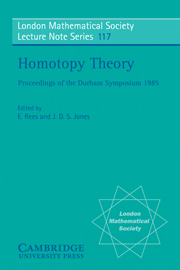Book contents
- Frontmatter
- Contents
- Preface
- On the computational complexity of rational homotopy
- Segal's Burnside ring conjecture and the homotopy limit problem
- Pseudo-isotopies, K-theory, and homotopy theory
- Global methods in homotopy theory
- Sur la cohomologie modulo p des p-groupes Abeliens elementaires
- A view of some aspects of unstable homotopy theory since 1950
- Recent Progress in Stable Splittings
- Localization and Periodicity in Homotopy Theory
- Symbolic calculus: a 19th century approach to MU and BP
- An outline of how manifolds relate to algebraic K-theory
Localization and Periodicity in Homotopy Theory
Published online by Cambridge University Press: 05 April 2013
- Frontmatter
- Contents
- Preface
- On the computational complexity of rational homotopy
- Segal's Burnside ring conjecture and the homotopy limit problem
- Pseudo-isotopies, K-theory, and homotopy theory
- Global methods in homotopy theory
- Sur la cohomologie modulo p des p-groupes Abeliens elementaires
- A view of some aspects of unstable homotopy theory since 1950
- Recent Progress in Stable Splittings
- Localization and Periodicity in Homotopy Theory
- Symbolic calculus: a 19th century approach to MU and BP
- An outline of how manifolds relate to algebraic K-theory
Summary
The study of the homotopy groups of spheres can be compared to astronomy. The groups themselves are like distant stars waiting to be discovered by the determined observer, who is constantly building better telescopes to see further into the distant sky. The telescopes are spectral sequences and other algebraic constructions of various sorts. Each time a better instrument is built new discoveries are made and our perspective changes. The more we find the more we see how complicated the problem really is.
We can distinguish three levels of ideas in the subject. The first (comparable to observational astronomy) is the collection of data about homotopy groups by various computational devices (see chapters 1, 3 and 7 of [Rl]). While this aspect of the subject is not fashionable and is seldom discussed in public, it is vital to the subject. Without experimental data there can be no valid theories.
Recently attempts have been made to use computers for this purpose by Bruner [Bru], Curtis-Goerss-Mahowald-Milgram [CGMM] and Tangora [Ta]. This subject is wide open and we hope to see more activity in it. There are many mathematical structures that could be exploited in designing software for this purpose. We have not yet seen a dramatic improvement over what was done earlier by hand, but there are grounds for optimism.
- Type
- Chapter
- Information
- Homotopy Theory: Proceedings of the Durham Symposium 1985 , pp. 175 - 194Publisher: Cambridge University PressPrint publication year: 1987
- 4
- Cited by

